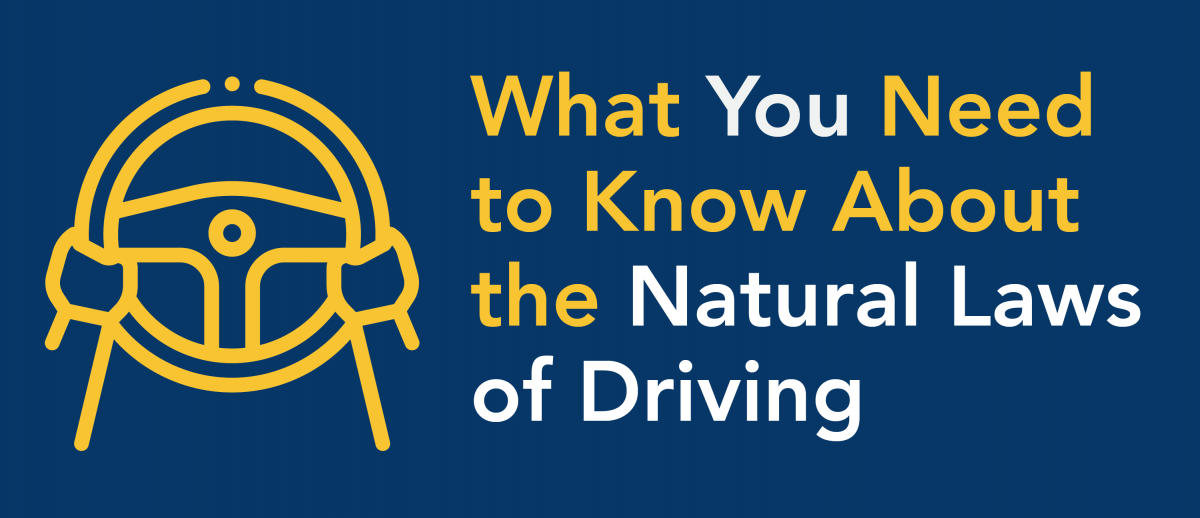All drivers should be aware of the natural laws of physics that affect any moving or stationary object.
While the rules of the road are of utmost importance to know and obey, understanding the natural laws of driving will help you be able to anticipate how your vehicle handles and reacts in various situations and instills confidence behind the wheel. Here we will go over some tips and tricks of controlling your vehicle against the natural laws of driving.
What Are the Natural Laws of Driving?
Gravity: the force that pulls all objects towards the center of the Earth. Everyone and everything experiences gravity and it has a major effect on your vehicle when driving uphill or downhill.
- When you are driving uphill gravity is working against you, meaning that it is pulling your vehicle in the opposite direction. You need to use more engine power in order to reach the top of the hill and to maintain the speed limit.
- When driving downhill, gravity will push your vehicle forward causing it to accelerate. It is a good idea to push your brakes gradually and slowly in order to slow down safely and to maintain control of your vehicle.
Inertia: The law of inertia states that:
- Object at rest tend to stay at rest
- Objects in motion tend to stay in motion at the same speed and direction
- Objects may change their motion only if influenced by an unbalanced force
The law of inertia applies to your vehicle as well as objects inside of it. A car will continue to move unless it is slowed down or stopped by another force — whether it be the brakes or an obstruction. So if, for example, you are driving 55mph, every object in the car is also moving 55mph; if the car hits a wall, all objects in the vehicle still move at 55mph — hence the importance of seatbelts, air bags and other safety features. For this reason, it is important to keep loose items secured inside of the vehicle.
Potential Energy: the energy that is stored in an object. The most common type of potential energy is when an object has the potential to “fall” or be pulled towards the center of the earth due to gravity. For example, when you park your car at the top of a hill, it has potential energy as gravity is pulling your car downward.
Kinetic Energy: the energy that is caused by motion. The kinetic energy of an object is the energy or force that the object has due to its motion. For example, a moving vehicle has kinetic energy and as you increase the speed of the vehicle, the kinetic energy of the vehicle increases as well. The more kinetic energy your vehicle has, the more effort required to stop the vehicle.
Friction: a force that is caused by the contact of one surface on another. When driving, keep in mind that friction is:
- Increased by the weight of your vehicle
- Decreased if your tires are over-inflated or under-inflated
- Decreased if your tires are worn smooth
- Affected by the material and condition of the road
Centrifugal and Centripetal Forces: these forces work opposite of each other and affect objects traveling on a curved path and will affect the way your vehicle behaves on the road. In order to understand these forces, imagine that any curve you drive on as part of a complete circle. The centripetal force pulls your vehicle to the center of the circle, while the centrifugal force pulls it away from the center. It is important to be aware of these forces when driving on a curved road and to find a balance between understeering (not turning the wheel enough) and oversteering (turning the wheel too much).
Momentum: the force that exists in a moving object. The momentum of an object is proportional to its weight and speed. When you are driving, you and your vehicle have obtained momentum that is based on the total weight of your vehicle and the speed at which you are driving. When slowing down or stopping your vehicle you must decrease the momentum of your vehicle by:
- Using the friction force of your brakes by utilizing your brakes,
- Using the friction force between your tires and the road, which is done automatically
- Using the compression force your engine by switching to a lower gear, if necessary
Importance of Understanding the Natural Laws of Driving
These forces affect how your vehicle works, despite the type or quality of the vehicle and the skills of the driver. While you don’t have to be actively thinking about physics while driving, these laws are important to understand as second nature because it will help you control your vehicle during turns, stops, and other everyday driving situations. Being informed and aware of how natural laws can affect driving can help you be alert to emergency situations and prevent crashes.
Once you gain an understanding of the natural laws of driving you can use your knowledge to:
- Determine how physics applies to your vehicle and be prepared for any situation
- Make safe and smart driving decisions
- Have more control over your vehicle
- Be conscious and aware of hazardous situations
Top Driver Driving Schools Will Prepare You
With more than 40 locations throughout Illinois, Michigan, and Ohio, Top Driver is your best resource for driver education, providing over 21,000 hours of in-vehicle training and 15,000 hours of classes each year. We have a variety of teen programs for new drivers, adult refresher courses, and remedial courses.
Top Driver is also going the extra mile to ensure a safe learning space for our students and instructors by providing remote classroom education opportunities and implementing a coronavirus vehicle sanitization process.
Call 1 (800) 374-8373 or enroll online today!
Additional Reading:
- What Should Be in Your Vehicle if Your Car Breaks Down?
- Everything You Need to know About REAL ID in Illinois

